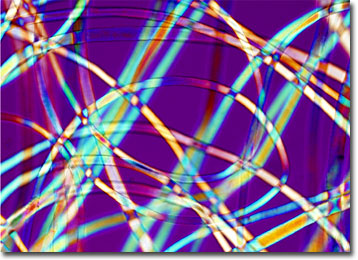Polarized Light Microscopy Digital Image Gallery
Wool
Sheepskins were donned by prehistoric man for warmth as many as 12,000 years ago. As civilizations developed, so did the processes of spinning and weaving, eventually enabling the production of a wide array of items composed from the fibers of the fleecy skins.

Wool fibers, which are primarily composed of keratin, exhibit numerous overlapping scales or plates that are all aligned in a single direction. When exposed to pressure, heat, and moisture, the scales of adjacent fibers interlock, forming the material known as felt. In a single inch of this material, there may be thousands of overlapping scales, which provides substantial strength to wool products while maintaining significant flexibility. Wool is also lightweight, highly absorbent, and readily dyed, making it a popular textile for apparel, rugs, and blankets.
Although wool is facing increasing competition from synthetic fibers in modern times, its importance throughout history has been tremendous. Traded as early as 4,000 BC and heavily utilized by the ancient Greeks and Romans, who introduced the art of wool production to many other parts of the world, wool fiber has been central in the amassing of innumerable fortunes. In fact, in the sixteenth century, Queen Elizabeth I commanded that nobles swearing their allegiance to the crown of England should kneel down upon a woolsack while doing so in remembrance of the role of wool in establishing the country’s tremendous strength and power.
